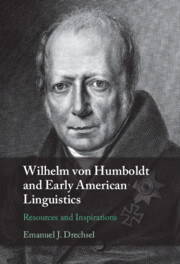Book contents
- Wilhelm von Humboldt and Early American Linguistics
- Wilhelm von Humboldt and Early American Linguistics
- Copyright page
- Dedication
- Contents
- Figures and Tables
- Maps
- Preface
- Acknowledgments
- Part I Wilhelm von Humboldt and the Americas
- Part II The Early Lives of Wilhelm and Alexander von Humboldt
- 3 The Humboldt Brothers’ Youth and Bildung in Europe of the Late Eighteenth Century
- 4 Alexander von Humboldt on His Explorations of the Americas and in His Role as His Brother’s Intermediary (1799–1804)
- 5 Wilhelm von Humboldt’s Linguistic and Ethnographic Field Experiences with Basque in the Pyrenees of Spain (1799 and 1801)
- Part III Wilhelm von Humboldt’s Americanist Linguistics
- Part IV Wilhelm von Humboldt’s Impact on Americanist Linguistics and Anthropology
- Part V Wilhelm von Humboldt as an Americanist Linguist and Anthropologist
- Book part
- References
- Index
5 - Wilhelm von Humboldt’s Linguistic and Ethnographic Field Experiences with Basque in the Pyrenees of Spain (1799 and 1801)
from Part II - The Early Lives of Wilhelm and Alexander von Humboldt
Published online by Cambridge University Press: 11 January 2024
- Wilhelm von Humboldt and Early American Linguistics
- Wilhelm von Humboldt and Early American Linguistics
- Copyright page
- Dedication
- Contents
- Figures and Tables
- Maps
- Preface
- Acknowledgments
- Part I Wilhelm von Humboldt and the Americas
- Part II The Early Lives of Wilhelm and Alexander von Humboldt
- 3 The Humboldt Brothers’ Youth and Bildung in Europe of the Late Eighteenth Century
- 4 Alexander von Humboldt on His Explorations of the Americas and in His Role as His Brother’s Intermediary (1799–1804)
- 5 Wilhelm von Humboldt’s Linguistic and Ethnographic Field Experiences with Basque in the Pyrenees of Spain (1799 and 1801)
- Part III Wilhelm von Humboldt’s Americanist Linguistics
- Part IV Wilhelm von Humboldt’s Impact on Americanist Linguistics and Anthropology
- Part V Wilhelm von Humboldt as an Americanist Linguist and Anthropologist
- Book part
- References
- Index
Summary
When Alexander was exploring the rainforest of northern South America at the turn of the nineteenth-century, Wilhelm pursued intensive sociolinguistic-ethnographic fieldwork on Basque, a non-Indo-European isolate, in the Pyrenees of Spain. Basque would attest as an ergative-absolutive language comparatively rare in Europe, but quite common in the Americas. Research on a language without a philological tradition required linguistic and anthropological field research, including the learning of its grammar, its uses and contexts, plus accompanying sociocultural customs. Humboldt recognized Basque as “a living image of their way of thinking and feeling,” for which he drew on proverbs, poetry, music, and dances. Conversely, distinctive Basque society was intelligible solely through the Basque language as part of an integrated theory of language in culture and society. Although Humboldt never identified Basque as Native American, his journey to the Pyrenees then became his substitute for a voyage to the Americas in the mind of German Humboldtians.
Keywords
- Type
- Chapter
- Information
- Wilhelm von Humboldt and Early American LinguisticsResources and Inspirations, pp. 81 - 92Publisher: Cambridge University PressPrint publication year: 2024



